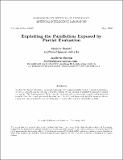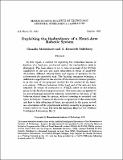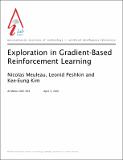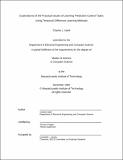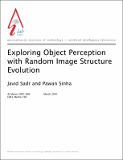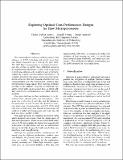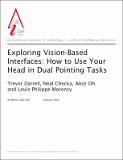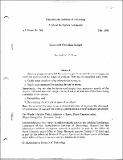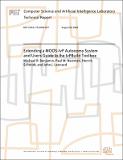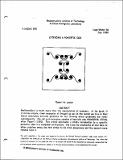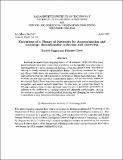Browsing Computer Science and Artificial Intelligence Lab (CSAIL) by Title
Now showing items 1179-1198 of 3804
-
Exploiting the Parallelism Exposed by Partial Evaluation
(1993-04-01)We describe an approach to parallel compilation that seeks to harness the vast amount of fine-grain parallelism that is exposed through partial evaluation of numerically-intensive scientific programs. We have constructed ... -
Exploiting the Parallelism Exposed by Partial Evaluation
(1994-05-01)We describe the key role played by partial evaluation in the Supercomputing Toolkit, a parallel computing system for scientific applications that effectively exploits the vast amount of parallelism exposed by partial ... -
Exploiting the Redundancy of a Hand-Arm Robotic System
(1990-10-01)In this report, a method for exploiting the redundancy of a hand-arm mechanical system for manipulation tasks is illustrated. The basic idea is to try to exploit the different intrinsic capabilities of the arm and hand ... -
Exploiting Transport-Level Characteristics of Spam
(2008-02-15)In the arms race to secure electronic mail users and servers fromunsolicited messages (spam), the most successful solutions employtechniques that are difficult for spammers to circumvent. Thisresearch investigates the ... -
Exploiting Vector Parallelism in Software Pipelined Loops
(2005-06-03)An emerging trend in processor design is the incorporation of short vector instructions into the ISA. In fact, vector extensions have appeared in most general-purpose microprocessors. To utilize these instructions, ... -
Exploration in Gradient-Based Reinforcement Learning
(2001-04-03)Gradient-based policy search is an alternative to value-function-based methods for reinforcement learning in non-Markovian domains. One apparent drawback of policy search is its requirement that all actions be 'on-policy'; ... -
Explorations in Low-Cost Compliant Robotics
(2007-01-30)This thesis presents the findings of exploratory research in low-cost compliant robotics. The most heavily leveraged trade-off is that of mechanical precision for computational power, with the hope that the price of future ... -
Explorations of the Practical Issues of Learning Prediction-Control Tasks Using Temporal Difference Learning Methods
(1992-12-01)There has been recent interest in using temporal difference learning methods to attack problems of prediction and control. While these algorithms have been brought to bear on many problems, they remain poorly understood. ... -
Exploring Object Perception with Random Image Structure Evolution
(2001-03-01)We have developed a technique called RISE (Random Image Structure Evolution), by which one may systematically sample continuous paths in a high-dimensional image space. A basic RISE sequence depicts the evolution of an ... -
Exploring Optimal Cost-Performance Designs for RAW processors
(1998-06)The semiconductor industry roadmap projects that advances in VLSI technology will permit more than one billion transistors on a chip by the year 2010. The MIT Raw microprocessor is a proposed architecture that strives to ... -
Exploring Vision-Based Interfaces: How to Use Your Head in Dual Pointing Tasks
(2002-01-01)The utility of vision-based face tracking for dual pointing tasks is evaluated. We first describe a 3-D face tracking technique based on real-time parametric motion-stereo, which is non-invasive, robust, and self-initialized. ... -
Expressing Mathematical Subroutines Constructively
(1987-11-01)The typical subroutines that compute $\\sin(x)$ and $\\exp(x)$ bear little resemblance to our mathematical knowledge of these functions: they are composed of concrete arithmetic expressions that include many mysterious ... -
Extended Gaussian Images
(1983-07-01)This is a primer on extended Gaussian Images. Extended Gaussian Images are useful for representing the shapes of surfaces. They can be computed easily from: 1. Needle maps obtained using photometric stereo, or 2. Depth ... -
Extending 2-D Smoothed Local Symmetries to 3-D
(MIT Artificial Intelligence Laboratory, 1985-11)3-D Smoothed Local Symmetries (3-D SLS's) are presented as a representation for three-dimensional shapes. 3-D SLS's make explicit the perceptually salient features of 3-D objects and are especially suited to representing ... -
Extending a MOOS-IvP Autonomy System and Users Guide to the IvPBuild Toolbox
(2009-08-20)This document describes how to extend the suite of MOOS applications and IvP Helm behaviors distributed with the MOOS-IvP software bundle from www.moos-ivp.org. It covers (a) a straw-man repository with a place-holder MOOS ... -
Extending a Powerful Idea
(1980-07-01)Mathematics is much more than the manipulation of numbers. At its best, it involves simple, clear examples of thought so apt to the world we live in that those examples provide guidance for our thinking about problems ... -
Extending Binary Byzantine Agreement to Multivalued Byzantine Agreement
(1984-04)A binary Byzantine agreement algorithm can be extended to produce a multivalued Byzantine agreement algorithm. The resulting multivalued algorithm is cheaper than previously published algorithms when the cost of transmitting ... -
Extending Guzman's SEE Program
(1970-07-01)Adolfo Guzman's SEE program groups the regions of a two-dimensional scene into bodies, using, using local evidence in the scene to link regions together. This paper discusses an extended version of the SEE procedure that ... -
Extensions of a Theory of Networks for Approximation and Learning: Dimensionality Reduction and Clustering
(1990-04-01)The theory developed in Poggio and Girosi (1989) shows the equivalence between regularization and a class of three-layer networks that we call regularization networks or Hyper Basis Functions. These networks are also ...


